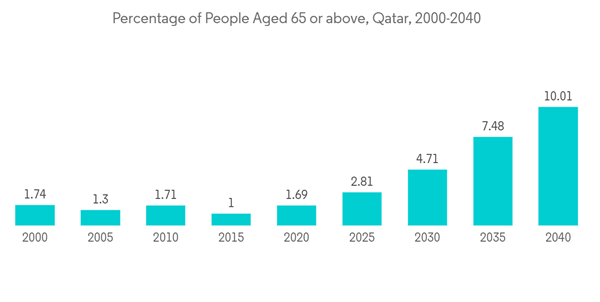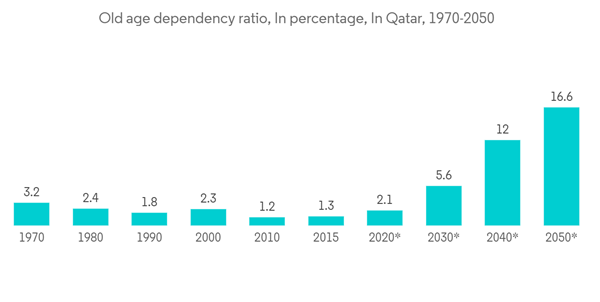The Qatar Senior Living Market size is estimated at USD 0.81 billion in 2024, and is expected to reach USD 1.86 billion by 2029, growing at a CAGR of 7.05% during the forecast period (2024-2029).
In 2022, the total population of Qatar was 2.69 million inhabitants, and about 1.5 percent of Qatar's total population was 65 years and older. It is expected to reach 10.01% by 2040, thus driving the market.
Following a 2020 and 2021 slump amid the COVID-19 pandemic, residential rents and senior housing prices in the region were expected to pick up, in line with anticipated increasing housing demand in 2023. The existing demand-supply gap in the housing sector indicates room for improvement and further action in the form of senior housing policies and subsidies.
While people are living longer, older persons are not necessarily in good health. In general, women in Bahrain live longer than men, but they experience poorer health conditions in old age. Poor health results in high medical expenses that older persons and their families must bear if social security programs do not cover them. In Bahrain, individuals without medical insurance have to pay out-of-pocket for treatment.
In the Arab region, formal old-age assistance is available primarily through ministries of social affairs, the United Nations Relief and Work Agency (UNRWA), and aid programs funded principally by the European Union and the World Bank. However, those programs are limited in scope and depend entirely on foreign donors, and therefore cannot guarantee beneficiaries a regular income or sustainable payments. In GCC countries, except Qatar, foreign workers are also not permitted to remain in the country once they reach retirement age, thus denying them pension coverage. The value for the Old age dependency ratio in Qatar was 21% as of 2022.
This product will be delivered within 2 business days.
Key Highlights
- The market is driven by increasing investment into operational real estate, expansion of rental, operators gaining experience, marketing suites re-opening after lockdowns, greater understanding of the proposition from investors and residents alike, and increased government focus (and spending) on the social care agenda.
- The COVID-19 pandemic severely impacted the senior living market as occupancy rates declined in the country and senior housing construction activities due to pandemic restrictions and social distancing protocols. In Qatar, senior housing has traditionally been focused on the sale model, with a price premium to reflect the added cost of providing communal facilities.
- In much of Qatar, elderly care is traditionally undertaken by younger generations. Multiple generations live together under one roof, with older generations caring for grandchildren and, in turn, children caring for aging parents. According to the developers and senior living community operators, the demand for under-construction units has doubled since the second wave of COVID-19, and most of this demand is generated by younger and middle-aged people in the country.
- Furthermore, the senior living market is driven by the increasing aged population in the country, growth in life expectancy, rise in nuclear families, financially independent and educated senior citizens, and increasing medical needs of the senior citizens.
- There are already various forms of senior housing being developed by domestic and international players. Investors are moving and diversifying across the residential investment space. Investors view senior housing as an extension of the residential investment market with differences around design, tenants, hospitality, and services.
- , registering a CAGR of 5 % during the forecast period (2023-2028).
- The COVID-19 pandemic severely impacted the senior living market as occupancy rates declined in the country and senior housing construction activities due to pandemic restrictions and social distancing protocols. In Qatar, senior housing has traditionally been focused on the sale model, with a price premium to reflect the added cost of providing communal facilities.
- The market is driven by increasing investment into operational real estate, expansion of rental, operators gaining experience, marketing suites re-opening after lockdowns, greater understanding of the proposition from investors and residents alike, and increased government focus (and spending) on the social care agenda.
- In much of Qatar, elderly care is traditionally undertaken by younger generations. Multiple generations live together under one roof, with older generations caring for grandchildren and, in turn, children caring for aging parents. According to the developers and senior living community operators, the demand for under-construction units has doubled since the second wave of COVID-19, and most of this demand is generated by younger and middle-aged people in the country.
- Furthermore, the senior living market is driven by the increasing aged population in the country, growth in life expectancy, rise in nuclear families, financially independent and educated senior citizens, and increasing medical needs of the senior citizens.
- There are already various forms of senior housing being developed by domestic and international players. Investors are moving and diversifying across the residential investment space. Investors view senior housing as an extension of the residential investment market with differences around design, tenants, hospitality, and services.
Qatar Senior Living Market Trends
Increase in Senior Population and Life Expectancy
The population of older persons in GCC countries has been increasing rapidly since the 1980s. As in most developed countries, the Arab region is experiencing significant gains in life expectancy at age 60. As life expectancy increases, quality of life and health issues become a growing concern for older persons.In 2022, the total population of Qatar was 2.69 million inhabitants, and about 1.5 percent of Qatar's total population was 65 years and older. It is expected to reach 10.01% by 2040, thus driving the market.
Following a 2020 and 2021 slump amid the COVID-19 pandemic, residential rents and senior housing prices in the region were expected to pick up, in line with anticipated increasing housing demand in 2023. The existing demand-supply gap in the housing sector indicates room for improvement and further action in the form of senior housing policies and subsidies.
Increase in Old Age Dependency Ratio
In all GCC countries, the proportions of older persons slightly declined from 1970 to 2015 (except in Bahrain, where the proportion stayed the same). Over the period 2015-2050, countries that will likely experience the fastest growth in the population of older persons are (in ascending order of growth) Saudi Arabia, Bahrain, Kuwait, Oman, Qatar, and the United Arab Emirates, with rates ranging from 5.2 percent to 7.5 percent. Countries with high positive net migration rates, caused mainly by labor migration, had small total dependency ratios, namely Bahrain, Kuwait, Oman, Qatar, and the United Arab Emirates.While people are living longer, older persons are not necessarily in good health. In general, women in Bahrain live longer than men, but they experience poorer health conditions in old age. Poor health results in high medical expenses that older persons and their families must bear if social security programs do not cover them. In Bahrain, individuals without medical insurance have to pay out-of-pocket for treatment.
In the Arab region, formal old-age assistance is available primarily through ministries of social affairs, the United Nations Relief and Work Agency (UNRWA), and aid programs funded principally by the European Union and the World Bank. However, those programs are limited in scope and depend entirely on foreign donors, and therefore cannot guarantee beneficiaries a regular income or sustainable payments. In GCC countries, except Qatar, foreign workers are also not permitted to remain in the country once they reach retirement age, thus denying them pension coverage. The value for the Old age dependency ratio in Qatar was 21% as of 2022.
Qatar Senior Living Industry Overview
The senior living market in Qatar is fragmented, with local and small developers present in the market. There exists high competition among the major players. In addition, companies are expanding their businesses through mergers, acquisitions, strategic partnerships, and new project launches to meet customer needs. Competition in the market is expected to increase with new companies as well. Landlords are actively trying to develop new housing in the country to get the benefits from the market.Additional Benefits:
- The market estimate (ME) sheet in Excel format
- 3 months of analyst support
This product will be delivered within 2 business days.
Table of Contents
1 INTRODUCTION
2 RESEARCH METHODOLOGY
4 MARKET INSIGHTS
5 MARKET DYNAMICS
6 MARKET SEGMENTATION
7 COMPETITIVE LANDSCAPE
Methodology

LOADING...










